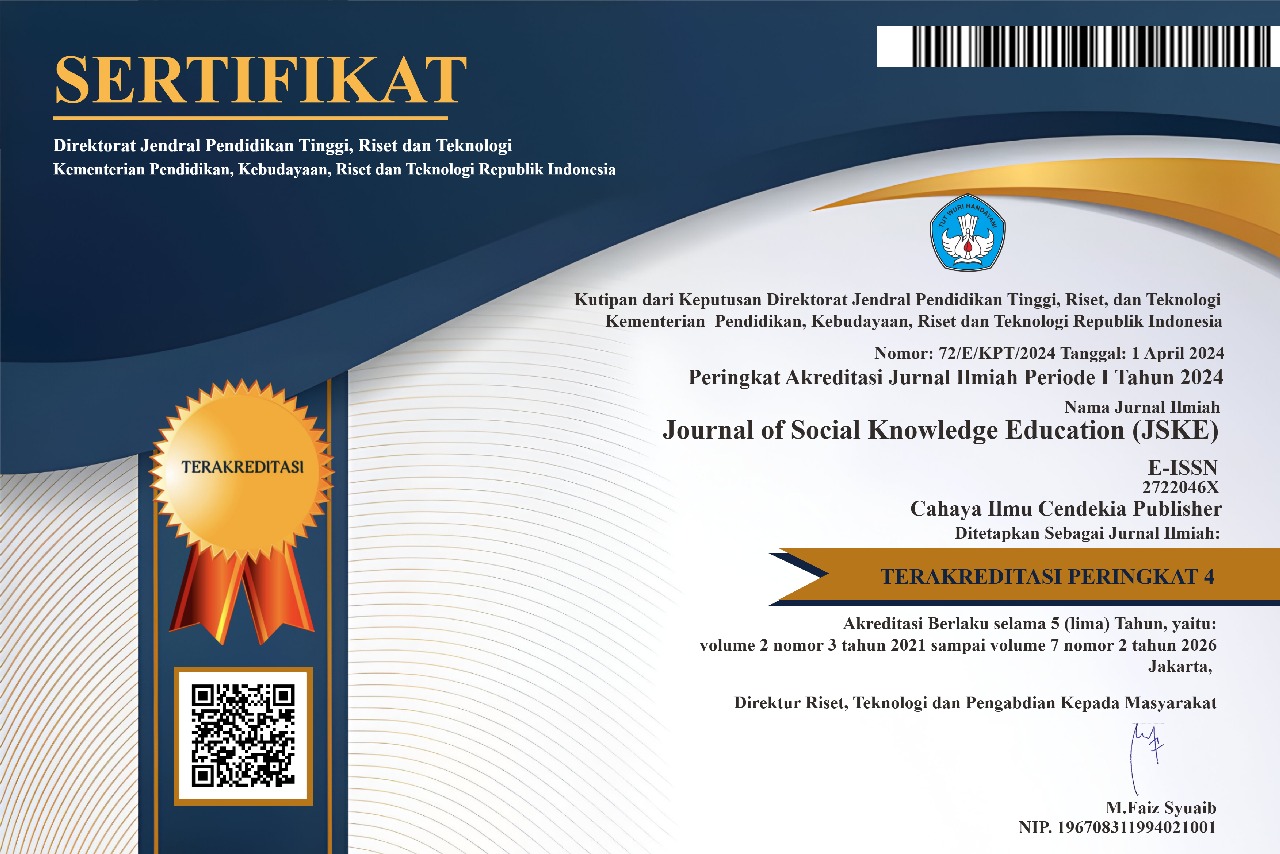Analysis of the Financial Literacy Level of Generation Z College Students and Its Implications for the Use of Paylater in the Context of Economic Education
Abstract
Purpose of the study: Describes the extent to which Gen Z students understand financial literacy and how it is applied to the use of PayLater.
Methodology: This study uses a qualitative descriptive approach by providing questionnaires to Gen Z students in the cities of Surabaya, Semarang, Malang, Lumajang, and Jember in April 2025.
Main Findings: The results show that the literacy level of Gen Z students is in the medium category. Then, the implication of this literacy level is that many respondents think that the use of paylater tends to influence shopping habits and can also influence lifestyle. Apart from that, regarding perceptions of paylater services as a whole, most respondents tend to choose neutral perceptions rather than positive or negative perceptions. Thus, there needs to be education through formal education, public campaigns, and easy access to financial information for students so that there is a balance between thinking ability and action in terms of financial management.
Novelty/Originality of this study: This study develops and expands the theory of financial literacy with Gen Z students as the object of research.
References
R. U. A. Fauzi, Konsep Dasar E-Commerce, 1st ed. Banjar: Ruang Karya Bersama, 2023.
R. Sari, “Pengaruh Penggunaan Paylater Terhadap Perilaku Impulse Buying Pengguna E-Commerce di Indonesia,” J. Ris. Bisnis dan Investasi, vol. 7, no. 1, pp. 44–57, 2021, doi: 10.35313/jrbi.v7i1.2058.
A. I. Rahmana, “Generasi Milenial Dominasi Pengguna BNPL di Indonesia, Capai 48,27% per November 2024,” 2025. https://keuangan.kontan.co.id/news/generasi-milenial-dominasi-pengguna-bnpl-di-indonesia-capai-4827-per-november-2024 (accessed Feb. 15, 2025).
A. Z. Yonatan, “Pengguna PayLater Indonesia Tumbuh 17 Kali Lipat dalam 5 Tahun Terakhir - GoodStats,” 2024. https://goodstats.id/article/pengguna-paylater-indonesia-tumbuh-17-kali-lipat-dalam-5-tahun-terakhir-355VL (accessed Feb. 13, 2025).
Silawati, “Pengguna Kredivo Hampir 10 Juta, Naik 20 Kali Lipat dalam 5 Tahun Terakhir,” 2024. https://kumparan.com/kumparanbisnis/pengguna-kredivo-hampir-10-juta-naik-20-kali-lipat-dalam-5-tahun-terakhir-22oTdxI1iyD (accessed Feb. 13, 2025).
N. Muhamad, “Milenial dan Gen Z Mendominasi Pengguna Paylater di Indonesia,” 2024. https://databoks.katadata.co.id/demografi/statistik/66b5d6e18dff3/milenial-dan-gen-z-mendominasi-pengguna-paylater-di-indonesia (accessed Feb. 13, 2025).
I. D. Purnama, “Gen Z Sampai Milenial Paling Banyak Ngutang, Totalnya Capai Rp14,74 Triliun,” 2021. https://sikapiuangmu.ojk.go.id/FrontEnd/CMS/Article/40800 (accessed Mar. 23, 2024).
N. N. J. M. Dewi, N. N. M. P. Dewi, Q. A’ini, and I. . R. Santhi, “Menumbuhkan Kesadaran Mahasiswa Generasi Z Agar Berperan Dalam Upaya Menjadi Agent Of Change Dalam Mencapai Society 5.0,” J. Japan Weld. Soc., vol. 91, no. 5, pp. 328–341, 2022, doi: 10.2207/jjws.91.328.
N. Garg and S. Singh, “Financial literacy among youth,” Int. J. Soc. Econ., vol. 45, no. 1, pp. 173–186, 2018, doi: https://doi.org/10.1108/IJSE-11-2016-0303.
A. Wibisono and N. Anastasia, “Pengaruh literasi keuangan dan demografi terhadap perencanaan pensiun pada individu pekerja di Surabaya,” vol. 4, no. 3, pp. 396–417, 2024.
A. Lusardi and O. S. Mitchell, “Financial literacy around the world: an overview,” J. Pension Econ. Financ., vol. 10, no. 4, pp. 497–508, 2011, doi: 10.1017/S1474747211000448.
F. A. S. Sihaloho, “Membangun Literasi Ekonomi Siswa : Peran Pendidikan Ekonomi dalam Pengambilan Keputusan Finansial,” vol. 08, no. 1, 2020.
A. Dwitri and S. Pradikto, “Pentingnya Literasi Keuangan Bagi Pengelolaan Keuangan Pribadi,” J. Kaji. dan Penelit. Umum, vol. 3, no. 1, 2025, doi: https://doi.org/10.47861/jkpu-nalanda.v3i1.1505.
A. Aisyahrani, “Peran Pendidikan Ekonomi dalam Meningkatkan Literasi Keuangan Mahasiswa,” Benefit J. Bussiness, Econ. Financ., vol. 2, no. 2, pp. 30–37, 2024, doi: 10.37985/benefit.v2i2.394.
M. F. Sabri, M. Macdonald, J. Masud, and L. Paim, “Financial Behavior and Problems among College Students in Malaysia: Research and Education Implication,” Consum. Interes. Annu., vol. 54, no. June 2020, pp. 166–170, 2008, [Online]. Available: https://www.researchgate.net/publication/341998516
F. Margaretha and R. A. Pambudhi, “Tingkat literasi keuangan pada mahasiswa s-1 fakultas ekonomi,” vol. 17, 2015, doi: 10.9744/jmk.17.1.76–85.
A. Roestanto, Literasi Keuangan. Yogyakarta: Istana Media, 2017.
L. P. Riani, A. A. H. S. Fikri, M. Sholeh, and Supriyanto, Literasi Keuangan Kaum Millenial :Tinjauan Faktor Anteseden dan Konsekuensi, 1st ed. Malang: MNC Publishing, 2023.
K. Laturette, L. P. Widianingsih, and L. Subandi, “Literasi Keuangan Pada Generasi Z,” J. Pendidik. Akunt., vol. 9, 2021, Accessed: Feb. 16, 2025. [Online]. Available: https://ejournal.unesa.ac.id/index.php/jpak/article/view/39272/37669
Y. Kristyowati, “Generasi ‘Z’ Dan Strategi Melayaninya,” vol. 02, no. 1, pp. 23–34, 2021, doi: 10.31219/osf.io/w3d7s.
F. Firdaus, F. M. Suryoputro, R. Z. Shafira, and M. W. Rizkyanfi, “Sistem Paylater Dalam E-Commerce: Pengaruhnya Terhadap Perilaku Impulse Buying,” Competitive, vol. 18, no. 1, pp. 9–14, 2023, doi: 10.36618/competitive.v18i1.2856.
C. E. Sedik, “Perbedaan Paylater vs Kartu Kredit, Pilih Mana?,” bisnis.com, 2023. https://finansial.bisnis.com/read/20230807/563/1682378/perbedaan-paylater-vs-kartu-kredit-pilih-mana (accessed Feb. 16, 2025).
I. E. Prastiwi and T. N. Fitria, “Konsep Paylater Online Shopping dalam Pandangan Ekonomi Islam,” J. Ilm. Ekon. Islam, vol. 7, no. 1, p. 425, 2021, doi: 10.29040/jiei.v7i1.1458.
D. Hermina, “Pendidikan dan pelatihan vokasional sebagai investasi sumber daya manusia terampil: Teori Ekonomi Pendidikan dan Beberapa Pendekatannya,” Khazanah J. Stud. Islam Dan Hum., vol. 7, no. 1, pp. 1–30, 2009, doi: https://doi.org/10.18592/khazanah.v7i1.3032.
G. Subroto, “Hubungan Pendidikan dan Ekonomi: Perspektif Teori dan Empiris,” J. Pendidik. Dan Kebud., vol. 20, no. 3, pp. 390–405, 2014, doi: https://doi.org/10.24832/jpnk.v20i3.318.
T. W. Schultz, “Intvestmenr in Human Capital,” Am. Econ. Rev., vol. 51, no. 1, pp. 1–17, 1961, [Online]. Available: http://www.jstor.org/stable/1818907 .
E. A. Hanushek and L. Woessmann, “The role of cognitive skills in economic development,” J. Econ. Lit., vol. 46, no. 3, pp. 607–668, 2008, doi: 10.1257/jel.46.3.607.
R. Madeamin, “Hubungan konsep ekonomi dan pendidikan dalam pengembangan sumber daya manusia,” J. Ilm. Manaj. Bisnis, vol. 5, pp. 175–184, 2008.
N. Hidayanti, D. P. Wiryaningtyas, F. Ariyantiningsih, and A. D. W. Ciptasari, “Pengaruh literasi keuangan dan persepsi risiko terhadap keputusan penggunaan shopee paylater melalui financial technology pada mahasiswa fakultas ekonomi dan bisnis abdurachman saleh situbondo,” J. Mhs. Entrep., vol. 2, no. 7, pp. 1471–1489, 2023.
E. Amaniyah and S. E. Sholehah, “Pengaruh literasi keuangan dan risiko terhadap perilaku konsumtif mahasiswa dengan penggunaan fintech payment (paylater) pada shopee sebagai variabel intervening,” J. Manag. Stud., vol. 18, no. 1, pp. 79–97, 2024.
F. D. Angelista, L. D. Anggraini, and A. U. Putri, “Pengaruh Literasi Keuangan , Gaya Hidup dan Sikap Keuangan Terhadap Perilaku Keuangan Mahasiswa Pengguna Shopee Paylater,” vol. 4, no. 3, pp. 696–705, 2024, doi: 10.47065/jtear.v4i3.1197.
D. M. Pratiwi and Z. B. Ni’am, “Pengaruh Literasi Keuangan, Gaya Hidup, dan Penggunaan Shopee Paylater terhadap Manajemen Keuangan Pribadi Mahasiswa,” vol. 4, no. 2, pp. 352–363, 2023.
A. Anggito and J. Setiawan, Metodologi Penelitian Kualitatif. Sukabumi: CV JEJAK, 2018. [Online]. Available: https://kubuku.id/detail/metodologi-penelitian-kualitatif/12351
A. F. Nasution, Metode Penelitian Kualitatif, 1st ed. Bandung: CV Harfa Creative, 2023.
F. R. Fiantika et al., metodologi penelitian kualitatif, 1st ed. Padang: PT. global eksekutif teknologi, 2022.
W. Yuliani, “Metode penelitian deskriptif kualitatif dalam perspektif bimbingan dan konseling,” QUANTA J. Kaji. Bimbing. dan Konseling dalam Pendidik., vol. 2, no. 2, pp. 83–91, 2018, doi: 10.22460/q.v2i1p21-30.642.
K. Amrullah, Metodologi Penelitian Kualitatif: Pengantar Teoritis Bagi Mahasiswa Pendidikan Bahasa Asing Edisi ke-2, 2nd ed. Malang: PT Literasi Nusantara Abadi Grup, 2024.
A. Hadi, Asrori, and Rusman, Penelitian kualitatif: studi fenomenologi, case study,grounded theory, etnografi, biografi, 1st ed. Banyumas: Cv Pena Persada, 2021.
M. B. Gainau, Pengantar Metode Penelitian, 1st ed. Sleman: PT Kanisius, 2021.
H. Chen and R. P. Volpe, “An Analysis of Personal Financial Literacy Among College Students,” Financ. Serv. Rev., vol. 7, no. 2, pp. 107–128, 1998, doi: 10.3788/CJL201643.0811001.
Copyright (c) 2025 Aji Prasetyo Suyono, Yulian Ade Chandra, Muhammad Mukhsin

This work is licensed under a Creative Commons Attribution 4.0 International License.
Authors who publish with this journal agree to the following terms:
- Authors retain copyright and acknowledge that the Journal of social knowledge education (JSKE) is the first publisher licensed under a Creative Commons Attribution 4.0 International License.
- Authors are able to enter into separate, additional contractual arrangements for the non-exclusive distribution of the journal's published version of the work (e.g., post it to an institutional repository or publish it in a book), with an acknowledgment of its initial publication in this journal.
- Authors are permitted and encouraged to post their work online (e.g., in institutional repositories or on their website) prior to and during the submission process, as it can lead to productive exchanges and earlier and greater citation of published work.







.png)
.png)















